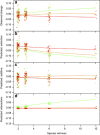Evolution of species interactions determines microbial community productivity in new environments
- PMID: 25387206
- PMCID: PMC4409166
- DOI: 10.1038/ismej.2014.215
Evolution of species interactions determines microbial community productivity in new environments
Abstract
Diversity generally increases ecosystem productivity over short timescales. Over longer timescales, both ecological and evolutionary responses to new environments could alter productivity and diversity-productivity relationships. In turn, diversity might affect how component species adapt to new conditions. We tested these ideas by culturing artificial microbial communities containing between 1 and 12 species in three different environments for ∼60 generations. The relationship between community yields and diversity became steeper over time in one environment. This occurred despite a general tendency for the separate yields of isolates of constituent species to be lower at the end if they had evolved in a more diverse community. Statistical comparisons of community and species yields showed that species interactions had evolved to be less negative over time, especially in more diverse communities. Diversity and evolution therefore interacted to enhance community productivity in a new environment.
Figures





References
-
- Bell G. The evolution of trophic structure. Heredity. 2007;99:494–505. - PubMed
-
- Bell T, Lilley AK, Hector A, Schmid B, King L, Newman JA. A linear model method for biodiversity-ecosystem functioning experiments. Am Nat. 2009;174:836–849. - PubMed
-
- Bell T, Newman JA, Silverman BW, Turner SL, Lilley AK. The contribution of species richness and composition to bacterial services. Nature. 2005;436:1157–1160. - PubMed
Publication types
MeSH terms
LinkOut - more resources
Full Text Sources
Other Literature Sources
Molecular Biology Databases

